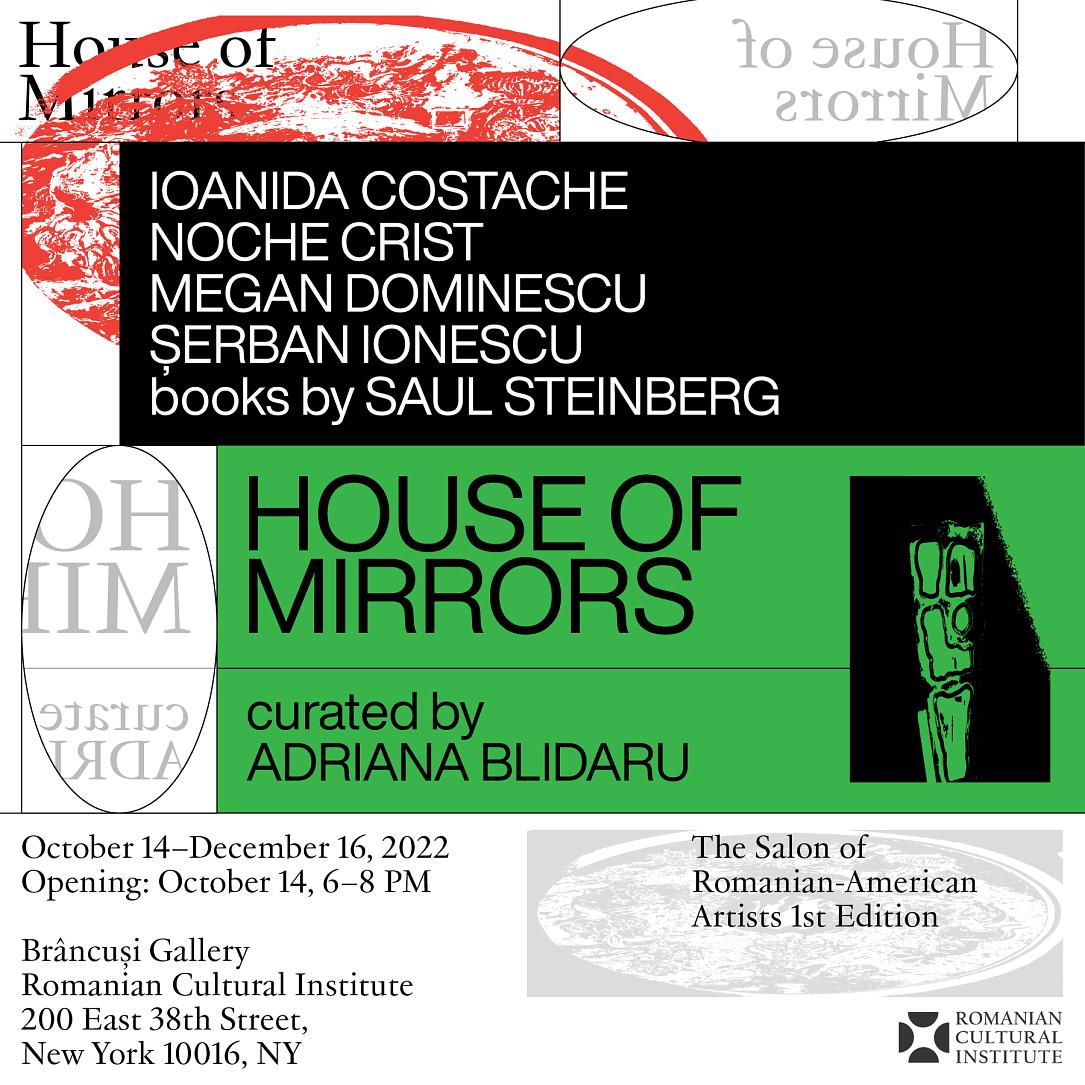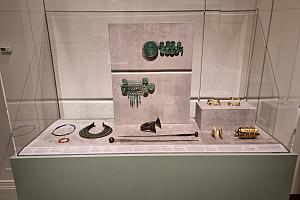House of Mirrors: First edition of the Romanian-American Artists Salon in New York

This autumn brings a new permanent program to the Romanian Cultural Institute in New York: the Romanian-American Artists Salon, which opens with an exhibition entitled House of Mirrors.
The program is part of the rich international tradition of art fairs and is intended to provide a special platform for promoting the creations of Romanian artists in the American diaspora, some of whom have not yet received the recognition they deserve.
The inaugural exhibition, House of Mirrors, curated by Adriana Blidaru, will open on October 14 with a special event taking place 6 pm - 8 pm, at the Brâncuși Gallery of the RCI New York.
The exhibition concept is based on the symbolism of a popular attraction, often found at fairs and amusement parks. The House of Mirrors is a labyrinth into which participants are invited to enter: mirrors represent paths as well as obstacles, generating sometimes frightening, sometimes humorous reflections.
The works presented are signed by five Romanian-American artists: Ioanida Costache, Noche Crist, Megan Dominescu, Șerban Ionescu, and Saul Steinberg. Their works explore the ways in which identity is constructed through the concepts of nationality, culture, history, and memory.
Although coming from different generations, the five artists relate to each other because of their shared interest in how identity is constructed, deformed, and reshaped, establishing through their creations a space that is both sensory and virtual, where subconscious narratives and fragments of memory compose a dreamlike universe.
About the artists
Ioanida Costache (b. 1989, Romania) is a violinist and video artist originally from Milwaukee, Oregon, where her parents settled after emigrating from Romania.
Ioanida earned a Ph.D. in Ethno-musicology from Stanford University (2021) and studied musicology and violin performance at Amherst College. She is currently a postdoctoral fellow in the humanities at the University of Pennsylvania, where her research explores issues of race and ethnicity, identity construction, cultural memory, and historical trauma at the intersection of Romani musical & oral traditions.
In her short documentary film Light Upon (2014), she creates a portrait of her first violin teacher, Nicu Ciotoi, addressing issues of identity and cultural heritage transmitted through music.
Noche Crist (b. 1909, Romania - d. 2004, USA), one of the legendary figures of the Washington art scene, was a self-taught artist of Romanian origin, known for her acrylic paintings on wood panels and resin sculptures. She arrived in the American capital in 1947 and became one of the co-founders of Gallery 10.
Many of her works refer to her earlier life in Romania, recalling her childhood spent on the family estate near Bucharest, but also containing dreamlike scenes in which women's bodies, often with animal heads, appear as mythical creatures from a personal cosmology.
In 1995, the Washington Project for the Arts organized a retrospective of 50 years of her work, and in 2008 another retrospective of her work was presented at the Katzen Arts Center.
Crist's work can be found in multiple international collections, including that of the Craiova Museum of Art. The artist is represented by the 2112 Gallery in Washington, D.C.
Megan Dominescu (b. 1997) is a Romanian-American visual artist living and working in Bucharest, Romania. She graduated from the Department of Painting at the National University of Arts in 2018.
Born in the Netherlands to Romanian and American parents, Megan grew up in Washington, D.C., but later decided to move to Romania. Cultural differences are a strong inspiration in her artistic practice. Using humor as a weapon, her creations focus on observing and documenting the absurd, highlighting cultural contrasts, and celebrating the bizarre.
The artist is a member of the multidisciplinary art space MOXA20 in Bucharest and is one half of the DJ duo Miss Clitoral. She is represented by the Anca Poterașu Galley in Bucharest.
Ṣerban Ionescu (b. 1984, Romania) grew up in New York and now divides his time between New York and Brussels. His work ranges from sculpture, painting, and design to architecture.
His creations, characterized by original lines resulting from a long practice of drawing, vibrant use of color, and a marked preference for the gestural nature of the artistic act, are based on a permanent intuitive play of shapes and dimensions.
The artist has had a series of solo exhibitions in New York at R & Company and Larrie and made his European debut with an exhibition in Antwerp, Belgium at Everyday Gallery. He holds a Bachelor of Architecture degree from Pratt Institute and taught at Rensselaer Polytechnic Institute's School of Architecture from 2010 to 2016.
His work has appeared in The New York Times, Dwell, Wallpaper, Apartamento, Elle Decor, and Architectural Digest.
Saul Steinberg (b. 1914, Romania - d. 1999, USA) was a Romanian-born American artist and illustrator, renowned for his covers and drawings published in The New Yorker for nearly six decades. He was equally appreciated for his drawings and for the paintings, prints, collages and sculptures he exhibited internationally in major galleries and museums.
Steinberg studied sociology and psychology at the University of Bucharest and architecture in Milan.
He first encountered anti-Semitism in elementary school, despite the fact that half of the school's students were Jewish. He faced the same prejudice during his high school years, where he took French, German, Latin, and Greek.
At the University of Bucharest, where he enrolled in 1932, anti-Semitism was even more prevalent. For this reason, he decided to leave Romania, eventually settling in 1942 in New York City, where he worked as a freelance artist, draughtsman, and illustrator.
Steinberg's subjects ranged from whimsical to satirical to philosophical. He made no distinction between high art and folk art, which he freely combined in a work that was extremely diverse stylistically but consistent in depth and visual imagination.
A number of museums and other art institutions hold works by Saul Steinberg. After his death, the Saul Steinberg Foundation was established in accordance with the artist's wishes.
Exhibition curator Adriana Blidaru (b. 1989, Romania) is the founding editor and curator of the online platform Living Content (New York) and has previously worked with Residency Unlimited, Swiss Institute, Rutgers University, Hessel Museum, Wendy's Subway, ICP, Judd Foundation, and P! as well as other international institutions and galleries.
She is also the curator of the Fire Sermon (PUBLIC, London), Cassandra Complex (basis e.V., Frankfurt), and Unconditional Lover (afterhours, Paris) exhibitions, which are currently open to the public.
The Brâncuși Gallery opened on September 17, 2021, at the end of an extensive renovation and redevelopment program of the CRI New York headquarters in the heart of Manhattan. The gallery aims to promote Romanian and Romanian-American artists, constituting a unique platform on the New York art scene for the expression of Romanian visual creativity.
More information is available here.
(Photo source: Romanian Cultural Institute)













